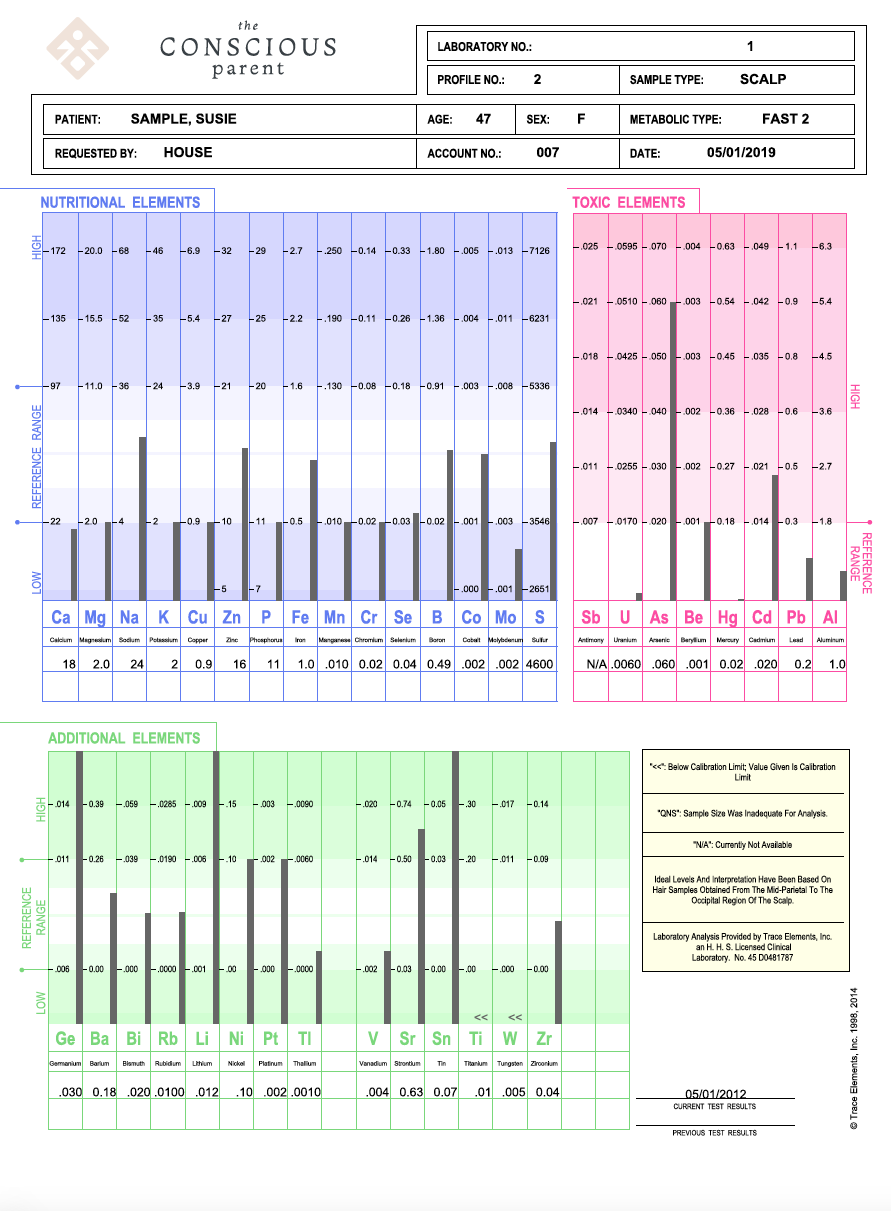Hair Tissue Mineral Analysis
Hair Tissue Mineral Analysis (HTMA) for Families
From The Conscious Parent Co
Reveal the hidden patterns behind energy, behaviour, skin, sleep and stress – for you and your child.
HTMA is a non-invasive laboratory test that measures levels of essential minerals and toxic metals in a small sample of hair.
It’s especially valuable for children and ideal for families seeking a gentle, deeper way to support health.
Non-invasive hair mineral analysis testing, perfect for kids
Benefits of Hair Tissue Mineral Analysis
What Hair tissue mineral analysis HTMA can reveal – and why it matters.
HTMA doesn’t just show if you’re low in calcium or magnesium.
It shows us why your skin keeps flaring
Why your child struggles to focus
Why your energy disappears by 3pm
Or why food reactions come and go without warning
It reveals:
Mineral deficiencies like zinc, magnesium, or potassium – often linked to poor sleep, low immunity, irritability and fatigue
Mineral excesses like copper – which can build up under stress and worsen mood, skin, histamine or hormonal symptoms
Toxic elements like lead, aluminium, or mercury – stored silently and often missed in blood tests
Stress patterns – how your body is burning through minerals just to keep going
Digestive and absorption clues – if your gut can’t break food down, it won’t absorb nutrients properly
HTMA gives you a clear starting point
Especially when standard tests say “you’re fine” – but nothing about you feels fine

Hair tissue mineral analysis for children
Why is hair tested?
Because the body stores what it can’t process.
When the body’s under stress, it doesn’t always excrete what’s harmful — it stores it.
Hair is one of the safest places the body uses to move excess minerals and toxic metals away from vital organs.
So what shows up in the hair can tell us a lot about what the body is carrying — and what it’s struggling to let go of.
It reflects what’s been building over time
Not just a moment in the bloodstream
Hair Tissue Mineral Analysis is especially valuable for children.
It helps identify nutritional deficiencies and toxic exposures that can impact their skin, sleep, development, and behaviour.
Because it’s non-invasive, it’s a stress-free way to see what’s really going on — even in little ones who can’t always explain how they feel
but show you with their body.
Discovery of mineral levels and any hidden toxic metals
Why Consider Hair Mineral Analysis
Because symptoms are messengers — and HTMA helps decode what they’re trying to say.
-
Detect mineral imbalances linked to low energy, anxiety, mood swings, poor sleep, or weak immunity
-
Identify hidden toxic metals like arsenic, aluminium, mercury, or lead — often missed by standard tests
-
See how your body is handling stress, and whether it’s burning through key nutrients just to cope
-
Understand long-term patterns — not just a snapshot in time
-
Support your child’s mood, skin, digestion, or focus with clarity instead of guesswork
-
Explore underlying factors that may be affecting your fertility, cycles, or hormonal health
-
Recognise signs of postnatal depletion — even years after giving birth — and gently begin to restore what was lost
-
Receive personalised, gentle guidance based on what your body actually needs — not a generic plan
HTMA helps you see the story behind the symptoms.
So you can respond with trust — not fear.

Example HTMA test result

Simple, Discreet and Painless
how it works
When you’re ready to go ahead, here’s what to expect:
-
You’ll receive a home test kit in the post
It includes everything you need to gently collect a small hair sample — no needles, no stress -
You send the sample back in the prepaid envelope
It’s analysed by a trusted laboratory using clinically validated methods to assess both mineral levels and toxic metals. -
You’ll receive your results by email from us (10-12 working days from when the lab receives your sample)
This includes a detailed lab report and personalised nutritional guidance based on your individual patterns
If you feel you’d benefit from deeper support, you’re welcome to explore a 1:1 appointment with one of our specialists.
You can also visit our FAQ section for answers to common questions.
the science explained
HTMA measures the following 35 elements: calcium, magnesium, sodium, potassium, copper, zinc, phosphorous, iron, manganese, chromium, selenium, cobalt, molybdenum, sulphur, germanium, barium, bismuth, rubidium, lithium, nickel, platinum, thallium, vanadium, strontium, tin, titanium, tungsten, zirconium, uranium, arsenic, beryllium, mercury, cadmium, lead and aluminium.
After you’ve taken the hair sample, place it into the special envelope we provide and mail it to us. Once it arrives at the laboratory, it undergoes a specialised preparation process before being placed in a series of test tubes for multiple analyses.
The scientific testing of a hair sample involves exposing it to high temperatures and special acids to break down the hair and separate it from its elements. Once the hair is completely digested, only the mineral salts remain. These salts are then added to a chemical solution and analysed to determine the mineral status and toxic metal accumulation in your body.
This precise process reveals the nutrient levels in your body and provides evidence of long-term or acute exposure to heavy metals, even those you may not have been aware of.
Hair Tissue Mineral Analysis (HTMA) FAQ for Children
Understanding Your Child’s Hair tissue mineral analysis HTMA Results
HTMA (Hair Tissue Mineral Analysis) measures the levels of essential minerals and toxic metals stored in your child’s hair over the past 3 to 4 months.
It’s completely non-invasive — no needles, no stress
And it gives you insight into what your child’s body might be holding, burning through, or missing
HTMA can reveal:
-
Mineral imbalances linked to emotional sensitivity, sleep issues, hyperactivity, anxiety, or poor focus
-
Toxic elements like lead, arsenic, aluminium or mercury — often stored in the body silently
-
Stress patterns — how your child’s nervous system is coping with growth, pressure, or their environment
-
Clues about digestion and absorption, especially if nutrient-rich food doesn’t seem to be helping
Because children often show us how they feel through their body or behaviour — not always with words — HTMA can provide answers where other tests come up short
It’s not a diagnosis
It’s a tool
To help you better understand your child — and support them with more clarity, not guesswork
Mineral ratios can provide insight into areas like:
Zinc/Copper Ratio: Imbalances here can contribute to mood swings, difficulty concentrating, and immune challenges.
Calcium/Magnesium Ratio: Highlights energy levels and stress handling.
Sodium/Potassium Ratio: Indicates adrenal health and resilience to stress.
Yes — skin is often one of the first places children show us that something is out of balance.
Conditions like eczema, rashes, dry skin, or flare-ups can be linked to mineral imbalances and toxic load
Even when creams and diets haven’t worked — the root issue may still be inside the body
HTMA can reveal:
-
Low zinc — which affects skin repair, immunity, and inflammation
-
High copper or calcium — which can trigger histamine reactions and worsen flares
-
Low sulphur or magnesium — making it harder for the body to detox through the liver, leaving the skin to take the strain
-
Toxic elements like arsenic or aluminium — which can impair barrier function or irritate the system over time
Your Childs skin is communicating
And their skin isn’t just acting out — it’s asking for support
HTMA can help identify what’s driving the inflammation, so you can begin to nourish the body from the inside out — with food, minerals, and gentle changes that actually support healing
Actionable Steps for Parents
(With somatic + nutritional insight)
Minerals aren’t just nutrients
They’re messengers.
They shape how your child responds to stress
How they recover from overwhelm
How they sleep, digest, focus, and feel safe in their body
Modern life depletes these reserves quickly
Through processed food, growth, medication, screen stimulation, and even inherited stress patterns
Rebuilding mineral balance starts with more than food
It starts with rhythm, safety, and connection
Magnesium
Supports: sleep, regulation, nervous system recovery
Found in: cacao, soaked seeds, bone broth, avocados
Somatic signs: can’t settle, fidgeting, clenched jaw, tension at bedtime
Energetic: magnesium is your “relax and let go” mineral
Calcium
Supports: structure, boundaries, emotional steadiness
Found in: grass-fed dairy, sardines with bones, sesame, tahini
Somatic signs: rigidity, withdrawal, stubbornness, overwhelm from noise
Energetic: calcium gives containment — but too much can create a shell
Zinc
Supports: skin, focus, growth, immunity
Found in: eggs, grass-fed meat, pumpkin seeds, soaked lentils
Somatic signs: picky eating, irritability, sensory sensitivity, poor wound healing
Energetic: zinc is the “repair and recover” mineral — often low in fast-growing children
If your child is vegetarian or sensitive
-
Focus on seaweed for trace minerals
-
Include sprouted seeds and soaked lentils to reduce blockers
-
Add fermented foods like tempeh or raw kraut to support absorption
And remember:
You’re not just feeding a body
You’re supporting a nervous system
Every nourishing bite
Every chance to play outside
Every boundary around screens
Every rhythm you hold
Rebuilds safety — inside and out
Not always — but in many cases, the right supplements can be a powerful part of your child’s healing journey.
Some children show clear mineral imbalances on their HTMA results, but due to picky eating, sensory issues, or stress, they simply can’t replenish those nutrients through food alone.
In these cases, targeted supplementation may be necessary — sometimes even long term — to restore balance and support healthy growth, sleep, mood, and focus.
The plan that comes with your HTMA test includes supplement suggestions based on your results.
However, it’s important to know that:
-
Many of these supplements are in capsule form, which can be opened — but the taste isn’t always child-friendly
-
Most have a savoury, mineral-heavy flavour, which tends to work better in soups or savoury foods than in sweet drinks
-
Some parents try mixing them with juice or yoghurt, but this often makes the food taste unpleasant and results in poor compliance
One exception is Min-Plex B, which blends well into dairy-based foods like yoghurt.
If you’re looking for more child-friendly options — such as liquids, powders, or chewables — or want to use a more personalised supplement strategy, working 1:1 with a practitioner allows us to:
-
Select forms that suit your child’s preferences and tolerance
-
Adjust doses carefully based on age, symptoms, and other health factors
-
Recommend brands we trust for quality, safety, and taste
-
Monitor how your child is responding over time, so support can evolve as needed
Not every child needs supplements.
But for those who do — the right format, dosage, and delivery can make all the difference.
Filtered Water: Reduces exposure to lead and other contaminants.
Low-Tox Products: Choose non-toxic cookware, toys, and personal care items.
Dust Control: Regular cleaning can reduce exposure to metals like lead from household dust.
Example: If your child shows high lead levels, reducing exposure from paint or contaminated water sources is critical alongside dietary detox support with sulphur-rich foods like eggs and garlic.
Behaviour, Focus, and Development
HTMA gives you insight into how your child’s brain and body are coping — long before symptoms become diagnoses.
Magnesium and sodium impact how the nervous system calms down after stimulation
Zinc and copper affect focus, frustration tolerance, and emotional steadiness
Potassium helps with resilience and recovery — especially in children who seem “burnt out” but wired
Sulphur plays a role in detox and histamine processing, which can affect skin, sleep, and emotional regulation
Toxic metals like arsenic, lead, or mercury can impair cognition, irritability, and behaviour — especially when exposure is ongoing or stored in the system
Calcium and phosphorus affect how information is absorbed, processed, and retained in the brain
Imbalances or extremes — even when nutrients are technically “high” — can signal deeper stress patterns or poor elimination
HTMA helps you move beyond labels and symptoms
It gives you a map of what your child’s body might be holding, burning through, or struggling to clear
So instead of guessing, you can begin supporting them with real clarity
Start small and think in rhythms, not rules.
-
Prioritise regular, nutrient-dense meals that feel grounding — even one solid meal a day can make a difference
-
Create space for outdoor movement and unstructured play, especially after emotional or sensory overload
-
Keep screens in balance — not from fear, but because they deplete minerals and pull the nervous system away from regulation
-
Gently observe what’s adding pressure — school, sleep disruption, social demands — and make adjustments where you can
-
Focus on connection over correction: a dysregulated child doesn’t need more structure, they need safety
You don’t need to do it all at once
Every small shift toward nourishment, presence, and clarity matters
Retesting and Monitoring Progress
Start small. Focus on what you can change, not everything at once.
Begin with one nourishing, nutrient-dense meal a day — something simple, grounding, and real.
Swap out one household product for a low-tox alternative, like a natural cleaner or a stainless steel pan.
Support your body’s detox pathways gently by drinking filtered water, reducing processed foods, and spending time outdoors.
If you feel unsure about how to address specific imbalances, a practitioner can help you make sense of your results and create a personalised plan — but you don’t need to do it all at once.
We recommend retesting every 3 to 4 months.
This allows you to track how your child’s mineral levels shift — especially during growth spurts, illness, or emotional changes.
It’s a way of staying in rhythm with their development
Not out of fear
But from a place of awareness, nourishment, and steady support
Over time, this consistent insight can help lay the foundations for deeper health, calmer behaviour, and stronger resilience — not just now, but as they grow.
Hair Tissue Mineral Analysis (HTMA) FAQ for Adults
Understanding your Hair tissue mineral analysis HTMA Results
HTMA (Hair Tissue Mineral Analysis) measures the levels of essential minerals and toxic metals stored in your hair over the past 3–4 months.
It gives you more than just a snapshot — it reveals longer-term patterns
How your body is responding to stress
What it might be holding onto
And whether it’s struggling to absorb or use certain nutrients
HTMA can highlight:
-
Mineral imbalances that affect your energy, sleep, mood, hormones, and immunity
-
Toxic elements like aluminium, arsenic, lead or mercury that may be interfering with nervous system regulation
-
Stress patterns in the body — from burnout to overdrive
-
Clues about digestion, absorption, and how well you’re actually using the nutrients you consume
Unlike blood tests, which reflect a moment in time, HTMA shows what’s building — or depleting — beneath the surface
It’s not a diagnosis
It’s a roadmap
And for many people, it’s the missing piece
Mineral ratios show us how your body is using what it has — not just how much is there
Sometimes your individual mineral levels might look “normal”
But the ratios between them tell a deeper story about stress, energy, hormones, and emotional resilience
Calcium/Magnesium Ratio
Often linked to stress, tension, and how energy is produced
-
High calcium, low magnesium can mean calcium isn’t being used properly — leading to muscle tightness, fatigue, or even calcium buildup in tissues
-
A high ratio can feel like you’re holding everything in — physically or emotionally
Sodium/Potassium Ratio
Sometimes called the “adrenal ratio”
-
Low sodium/potassium often reflects burnout, depletion, or that flat, wired-but-tired state
-
High sodium/potassium can signal acute stress or inflammation
This ratio often mirrors how well your body is coping with pressure
Zinc/Copper Ratio
Strongly tied to mental health, immunity, and hormonal balance
-
Low zinc, high copper is commonly linked to anxiety, overwhelm, and hormonal symptoms like PMS or skin issues
-
Balancing this ratio gently over time can improve mood, clarity, and emotional stability
These patterns don’t define you
But they help you understand why you feel the way you do
HTMA offers more than a snapshot — it offers a map of how your body is adapting
And where it might need support to come back into balance
High Levels: High levels can indicate poor utilisation or the body’s effort to excrete excess amounts. For example, high calcium may mean it’s being stored in soft tissues rather than used in bones, potentially contributing to stiffness or joint pain.
Low Levels: Often reflect dietary deficiencies, poor absorption, or depletion due to stress or illness. For example, low magnesium may manifest as fatigue, muscle cramps, or sleep disturbances.
Examples:
High Sodium/Potassium: May suggest an acute stress response, leading to irritability or trouble concentrating.
Low Zinc/High Copper: Commonly associated with mood swings or poor immune function.
What to Do Next
When you’re depleted, food is more than fuel — it’s information.
And the type of food matters as much as the minerals themselves.
We focus on nutrient-dense, bioavailable foods — the kind your body can absorb easily without extra strain on digestion.
This is especially important when you’re burnt out, recovering, or dealing with gut or hormonal issues.
Start here:
Magnesium
Supports: energy, muscle relaxation, sleep, nervous system regulation
Found in: bone broth, cacao, soaked nuts and seeds, dark chocolate, avocado, pumpkin seeds
Signs of low magnesium: fatigue, anxiety, cramps, light sleep, sensory overwhelm
Calcium
Supports: bone strength, calm focus, nerve signalling, hormonal rhythm
Found in: grass-fed dairy, small fish with bones (like sardines), tahini, sesame, almonds
Note: fortified plant milks offer quantity, but not always quality — look for absorbable forms
Signs of poor calcium use: joint pain, rigidity, nervous tension
Potassium
Supports: fluid balance, heart health, muscle tone, adrenal function
Found in: coconut water, avocado, root veg, beetroot, banana
Often overlooked — but critical for burnout, blood pressure and anxiety
Signs of low potassium: fatigue, muscle weakness, blood sugar crashes
Zinc
Supports: immunity, wound healing, skin health, focus
Found in: oysters, grass-fed meat, pumpkin seeds, chickpeas (soaked), sprouted lentils
Signs of low zinc: recurrent infections, slow healing, poor skin, loss of taste or smell
For vegetarian or plant-focused diets
-
Include seaweed for iodine and trace minerals
-
Use soaked and sprouted seeds, grains, and legumes to improve absorption
-
Pair iron- or zinc-rich plant foods with vitamin C to increase uptake
This isn’t about eating perfectly
It’s about feeding the body in ways that are calming, consistent, and mineral-rich — so your nervous system can stop running on reserves
Food is always the foundation
But in today’s world — stress, soil depletion, medications, gut issues, and blood sugar swings often mean food alone isn’t enough to restore balance
Many people are low in minerals like magnesium, zinc, potassium, or sodium — even with a good diet
And these deficiencies can show up as fatigue, anxiety, poor sleep, joint pain, and emotional overwhelm
In those cases, supplements can offer targeted support
Especially when they’re:
-
In bioavailable forms (like magnesium glycinate or zinc picolinate)
-
Taken in the right dose and rhythm
-
Paired with the right food and lifestyle choices
But supplements aren’t always simple
Taking the wrong ones — or too many — can create new imbalances
That’s why we always recommend working with a practitioner who understands your full picture, not just the result on paper
You don’t need a cupboard full of pills
You need clarity on what your body’s asking for — and how to support it in a way that feels sustainable
Mineral balance isn’t just about what you eat
It’s about how you live
Because stress, sleep, hydration, and toxin exposure all shape how your body uses — and loses — minerals like magnesium, potassium, and sodium
Stress
Chronic stress rapidly depletes magnesium and potassium — the very minerals that help you stay calm, grounded, and regulated
If you’re always in fight-or-flight, your body burns through these resources just to keep you upright
Practices like breathwork, rest, time in nature, and nervous system support are not extras — they’re essential
Hydration
Drinking enough water isn’t enough if the minerals aren’t there
Use filtered water, and consider adding trace minerals or sea salt to support kidney function and electrolyte balance
Without minerals, water can actually dilute your reserves further
Toxin Exposure
Aluminium, mercury, and other toxic elements compete with essential minerals and add to the body’s burden
Swap non-stick and aluminium cookware for cast iron or stainless steel
Reduce processed food and synthetic additives wherever possible
It’s not about fear — it’s about giving your body a little less to fight off every day
These changes don’t need to happen overnight
But they do matter
Because food is only one part of the picture — and minerals are part of the whole
Supplements are only helpful when your body can actually use them
And that depends on more than the ingredients in the bottle
If you’re low in stomach acid (HCl), you might not be absorbing minerals properly — especially things like zinc or calcium
If you’re missing cofactors like vitamin C, B6, or potassium, your body might not be able to use what you’re taking — or it may push things out too fast
Some supplements — especially detox support — can stir up metals or stored toxins
If your drainage and elimination pathways aren’t open, this can make you feel worse before you feel better
That’s why we don’t believe in taking everything at once
We focus on building foundations first — food, nervous system, gut function
Then gently layering in the right support, in the right order
Supplements should feel like support — not stress
Yes — HTMA is safe to do while pregnant or breastfeeding.
It’s non-invasive and doesn’t affect your baby in any way.
That said, interpretation during these times needs to be done carefully.
Pregnancy and breastfeeding both change how your body uses and prioritises minerals — often favouring your baby over your own stores.
This means:
-
Some levels may appear artificially low or high due to biological shifts
-
Detox protocols are not recommended during this time
-
The focus is always on gentle replenishment, not removal
HTMA can still be incredibly helpful during this window — especially if you’re feeling:
-
Fatigued
-
Wired but exhausted
-
Anxious
-
Struggling to recover postpartum
-
Depleted despite “eating well”
It gives you a clearer view of what your body might be missing — and what it needs to feel more supported
If you’re unsure, we always recommend working with a practitioner who understands the unique needs of pregnancy and postnatal care
Detoxification and Heavy Metals
Toxic metals like lead, mercury, arsenic, and aluminium can interfere with how your body functions — from energy production and mood regulation to immune defence and brain clarity.
These metals often build up quietly over time.
HTMA can show us what the body has been storing — especially when elimination pathways are under pressure.
If certain metals show up high on your results, it’s a sign that your body may need gentle support, not a harsh detox.
Everyday steps can help reduce exposure and support elimination naturally:
-
Water filtration — to remove metals like lead and arsenic at the source
-
Sulphur-rich foods — like garlic, onions, and eggs to support liver detox pathways
-
Sweating gently — through movement, sauna, or time outdoors
-
Reducing common exposures — for example, aluminium in cookware, cosmetics, or foil
These changes don’t need to happen all at once
Small shifts, over time, can help your body clear what no longer serves it
If toxic metals show up on your HTMA, it’s natural to want to “get them out” quickly.
But detox isn’t about pushing — it’s about timing, safety, and what your body can actually handle.
We don’t recommend aggressive detox protocols without guidance.
They can do more harm than good if your system isn’t ready.
A practitioner can help you understand what your results really mean
and support your body in releasing metals gently — when the foundations are in place
This process should never feel extreme
It should feel manageable, respectful, and tailored to you
Retesting and Monitoring Progress
We recommend retesting every 3 to 6 months to track your progress and adjust your support based on what your body is doing now — not just what it was doing before.
Sometimes, second tests can look “worse” at first glance — and that’s completely normal.
It may mean your body is:
-
Starting to release stored toxic metals
-
Mobilising minerals that were previously stuck or suppressed
-
Showing stress patterns that were masked when you were more depleted
Retesting isn’t about getting a perfect result
It’s about seeing the direction your body is moving in
So you can respond with the right support — not guess
Even if things look more intense on paper
It’s often a sign that something deeper is shifting
HTMA shows long-term patterns — not moment-to-moment snapshots.
So it may not always line up perfectly with how you’re feeling today.
You might feel exhausted even if your mineral levels appear “normal.”
You might feel better, even as stored metals begin to rise on paper.
That doesn’t mean the test is wrong
It means your body is shifting
And healing rarely happens in a straight line
HTMA is one piece of the picture
It helps you ask better questions — not just chase perfect numbers
Sometimes the insight is obvious
Sometimes it’s subtle
But it always gives us a starting point
Disclaimer: This is intended for informational purposes only and is not a substitute for professional medical advice. Always consult with a qualified practitioner for personalised guidance.
Hair tissue mineral analysis (HTMA) provided by Mineral Check Ltd. Internationally recognised laboratory
Hair Tissue Mineral Analysis
Hair Tissue Mineral Analysis for Kids: What Every Parent Should Know
Hair Tissue Mineral Analysis for Kids: What Every Parent Should Know Is your child tired, wired, or…



